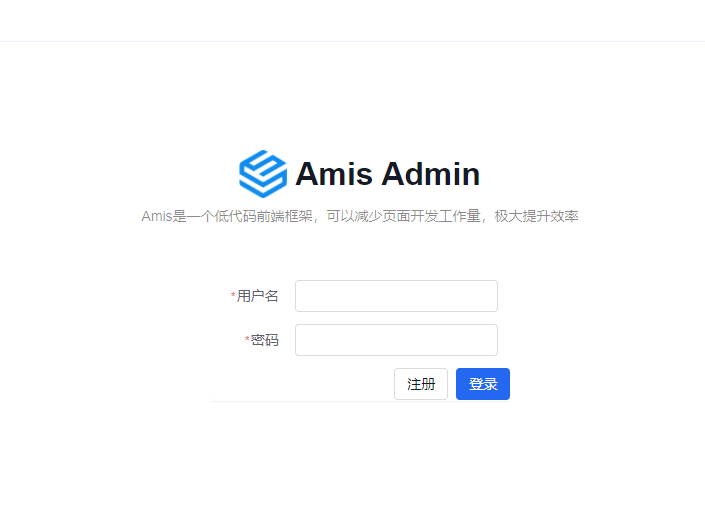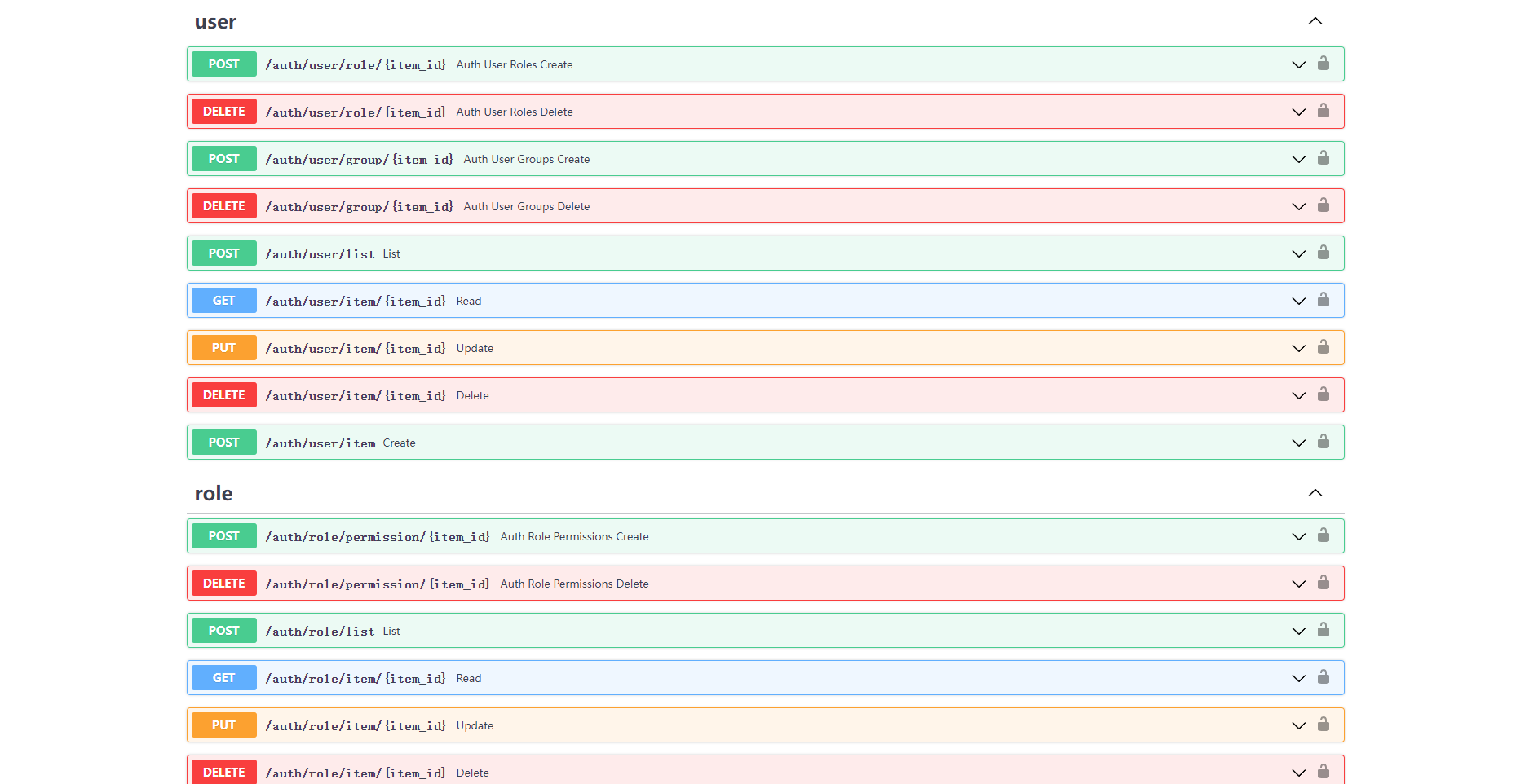FastAPI-User-Auth is a simple and powerful FastAPI user RBAC authentication and authorization library. Based on FastAPI-Amis-Admin and provides a freely extensible visual management interface.
Project description
Project Introduction
FastAPI-User-Auth
FastAPI-User-Auth is a simple and powerful FastAPI user authentication and authorization library based on Casbin.
Based on FastAPI-Amis-Admin and provides a freely extensible visual management interface.
Source code · Online demo · Documentation · can't open the document ?
FastAPI-User-Auth is a API based on FastAPI-Amis-Admin
The application plug-in is deeply integrated with FastAPI-Amis-Admin to provide user authentication and authorization.
Casbin-based RBAC permission management supports multiple verification methods, multiple databases, and multiple granularity permission controls.
Permission types
- Page Permissions: Control whether the user can access a certain menu page. If it is not accessible, the menu will not be displayed, and all routes under the page will be inaccessible.
- Action Permission: Controls whether the user can perform an action and whether the button is displayed. For example: add, update, delete, etc.
- Field permissions: Control whether users can operate a certain field. For example: list display fields, filter fields, add fields, update fields, etc.
- Data permissions: Control the range of data that users can operate. For example: they can only operate the data they created, only the data of the last 7 days, etc.
Installation
pip install fastapi-user-auth
Simple example
from fastapi import FastAPI
from fastapi_amis_admin.admin.settings import Settings
from fastapi_user_auth.site import AuthAdminSite
from starlette.requests import Request
from sqlmodel import SQLModel
# Create FastAPI application
app = FastAPI()
# Create AdminSite instance
site = AuthAdminSite(settings=Settings(database_url='sqlite:///amisadmin.db?check_same_thread=False'))
auth = site.auth
# Mount the backend management system
site.mount_app(app)
# Create initial database table
@app.on_event("startup")
async def startup():
await site.db.async_run_sync(SQLModel.metadata.create_all, is_session=False)
# Create a default administrator, username: admin, password: admin, please change the password in time!!!
await auth.create_role_user("admin")
#Create the default super administrator, username: root, password: root, please change the password in time!!! await auth.create_role_user("root")
# Run the startup method of the site, load the casbin strategy, etc.
await site.router.startup()
#Add a default casbin rule
if not auth.enforcer.enforce("u:admin", site.unique_id, "page", "page"):
await auth.enforcer.add_policy("u:admin", site.unique_id, "page", "page", "allow")
# Requirements: User must be logged in
@app.get("/auth/get_user")
@auth.requires()
def get_user(request: Request):
return request.user
if __name__ == '__main__':
import uvicorn
uvicorn.run(app)
Authentication methods
Decorator
- Recommended scenario: Single route. Supports synchronous/asynchronous routing.
# Requirements: User must be logged in
@app.get("/auth/user")
@auth.requires()
def user(request: Request):
return request.user # Current request user object.
# Verify routing: user has admin role
@app.get("/auth/admin_roles")
@auth.requires('admin')
def admin_roles(request: Request):
return request.user
# Requirement: User has VIP role
#Support synchronous/asynchronous routing
@app.get("/auth/vip_roles")
@auth.requires(['vip'])
async def vip_roles(request: Request):
return request.user
# Requirement: User has admin role or vip role
@app.get("/auth/admin_or_vip_roles")
@auth.requires(roles=['admin', 'vip'])
def admin_or_vip_roles(request: Request):
return request.user
Dependencies (recommended)
- Recommended scenarios: single route, route set, FastAPI application.
from fastapi import Depends
from fastapi_user_auth.auth.models import User
# Route parameter dependencies, this method is recommended
@app.get("/auth/admin_roles_depend_1")
def admin_roles(user: User = Depends(auth.get_current_user)):
return user # Current request user object.
# Path manipulation decorator dependencies
@app.get("/auth/admin_roles_depend_2", dependencies=[Depends(auth.requires('admin')())])
def admin_roles(request: Request):
return request.user
# Global dependencies
# All requests under the app require the admin role
app = FastAPI(dependencies=[Depends(auth.requires('admin')())])
@app.get("/auth/admin_roles_depend_3")
def admin_roles(request: Request):
return request.user
Middleware
- Recommended scenario: FastAPI application
app = FastAPI()
# Attach `request.auth` and `request.user` objects before each request is processed under the app application
auth.backend.attach_middleware(app)
Call directly
- Recommended scenario: non-routing method
from fastapi_user_auth.auth.models import User
async def get_request_user(request: Request) -> Optional[User]:
# user= await auth.get_current_user(request)
if await auth.requires('admin', response=False)(request):
return request.user
else:
return None
Token Storage Backend
fastapi-user-auth supports multiple token storage methods. The default is: DbTokenStore, it is recommended to customize it to: JwtTokenStore
JwtTokenStore
pip install fastapi-user-auth[jwt]
from fastapi_user_auth.auth.backends.jwt import JwtTokenStore
from sqlalchemy_database import Database
from fastapi_user_auth.auth import Auth
from fastapi_amis_admin.admin.site import AuthAdminSite
#Create a sync database engine
db = Database.create(url="sqlite:///amisadmin.db?check_same_thread=False")
# Use `JwtTokenStore` to create an auth object
auth = Auth(
db=db,
token_store=JwtTokenStore(secret_key='09d25e094faa6ca2556c818166b7a9563b93f7099f6f0f4caa6cf63b88e8d3e7')
)
# Pass auth object to AdminSite
site = AuthAdminSite(
settings=Settings(),
db=db,
auth=auth
)
DbTokenStore
# Create an auth object using `DbTokenStore`
from fastapi_user_auth.auth.backends.db import DbTokenStore
auth = Auth(
db=db,
token_store=DbTokenStore(db=db)
)
RedisTokenStore
pip install fastapi-user-auth[redis]
# Use `RedisTokenStore` to create an auth object
from fastapi_user_auth.auth.backends.redis import RedisTokenStore
from redis.asyncio import Redis
auth = Auth(
db=db,
token_store=RedisTokenStore(redis=Redis.from_url('redis://localhost?db=0'))
)
RBAC model
This system adopts the Casbin RBAC model and runs a role-based priority strategy.
- Permissions can be assigned to roles or directly to users.
- Users can have multiple roles.
- A role can have multiple sub-roles.
- The permission policy owned by the user has a higher priority than the permission policy of the role it owns.
flowchart LR
User -. m:n .-> Role
User -. m:n .-> CasbinRule
Role -. m:n .-> Role
Role -. m:n .-> CasbinRule
Advanced expansion
Extend the User model
from datetime import date
from fastapi_amis_admin.models.fields import Field
from fastapi_user_auth.auth.models import BaseUser
# Customize the `User` model, inherit `BaseUser`
class MyUser(BaseUser, table = True):
point: float = Field(default = 0, title = 'Point', description = 'User points')
phone: str = Field(None, title = 'Phone', max_length = 15)
parent_id: int = Field(None, title = "Superior", foreign_key = "auth_user.id")
birthday: date = Field(None, title = "date of birth")
location: str = Field(None, title = "Location")
# Use custom `User` model to create auth object
auth = Auth(db = AsyncDatabase(engine), user_model = MyUser)
Extend the Role model
from fastapi_amis_admin.models.fields import Field
from fastapi_user_auth.auth.models import Role
# Customize `Role` model, inherit `Role`;
class MyRole(Role, table=True):
icon: str = Field(None, title='图标')
is_active: bool = Field(default=True, title="是否激活")
Customize User Auth App default management class
The default management classes can be overridden and replaced through inheritance.
For example: UserLoginFormAdmin, UserRegFormAdmin, UserInfoFormAdmin,
UserAdmin,RoleAdmin
# Customize the model management class, inherit and override the corresponding default management class
class MyRoleAdmin(admin.ModelAdmin):
page_schema = PageSchema(label='User group management', icon='fa fa-group')
model = MyRole
readonly_fields = ['key']
# Customize user authentication application, inherit and override the default user authentication application
class MyUserAuthApp(UserAuthApp):
RoleAdmin = MyRoleAdmin
# Customize the user management site, inherit and override the default user management site
class MyAuthAdminSite(AuthAdminSite):
UserAuthApp = MyUserAuthApp
# Use the custom `AuthAdminSite` class to create a site object
site = MyAuthAdminSite(settings, auth=auth)
ModelAdmin permission control
Field permissions
-
Inherit the
AutoField ModelAdminclass to achieve field permission control. By assigning user and role permissions in the background. -
perm_fields_exclude: Specify fields that do not require permission control.
from fastapi_user_auth.mixins.admin import AuthFieldModelAdmin
from fastapi_amis_admin.amis import PageSchema
from fastapi_amis_admin.admin import FieldPermEnum
class AuthFieldArticleAdmin(AuthFieldModelAdmin):
page_schema = PageSchema(label="文章管理")
model = Article
# Specify fields that do not need permission control.
perm_fields_exclude = {
FieldPermEnum.CREATE: ["title", "description", "content"],
}
Data permissions
- Inherit the
AuthSelectModelAdminclass to achieve data permission control. By assigning user and role permissions in the background. select_permisions: Specify permissions to query data.
from fastapi_user_auth.mixins.admin import AuthSelectModelAdmin
from fastapi_amis_admin.amis import PageSchema
from fastapi_amis_admin.admin import RecentTimeSelectPerm, UserSelectPerm, SimpleSelectPerm
class AuthSelectArticleAdmin(AuthSelectModelAdmin):
page_schema = PageSchema(label="Dataset control article management")
model = Article
select_permissions = [
# Data created in the last 7 days. reverse=True indicates reverse selection, that is, the data within the last 7 days is selected by default.
RecentTimeSelectPerm(name="recent7_create", label="Created in the last 7 days", td=60 * 60 * 24 * 7, reverse=True),
# Data created in the last 30 days
RecentTimeSelectPerm(name="recent30_create", label="Created in the last 30 days", td=60 * 60 * 24 * 30),
#Data updated in the last 3 days
RecentTimeSelectPerm(name="recent3_update", label="Updated in the last 3 days", td=60 * 60 * 24 * 3, time_column="update_time"),
# You can only select the data you created. reverse=True means reverse selection, that is, the data you created is selected by default.
UserSelectPerm(name="self_create", label="Create yourself", user_column="user_id", reverse=True),
# # You can only select the data you updated
# UserSelectPerm(name="self_update", label="Update yourself", user_column="update_by"),
# Only published data can be selected
SimpleSelectPerm(name="published", label="Published", column="is_published", values=[True]),
# Only data with status [1,2,3] can be selected
SimpleSelectPerm(name="status_1_2_3", label="Status is 1_2_3", column="status", values=[1, 2, 3]),
]
Interface preview
- Open
http://127.0.0.1:8000/admin/auth/form/loginin your browser:
- Open
http://127.0.0.1:8000/admin/in your browser:
- Open
http://127.0.0.1:8000/admin/docsin your browser:
License Agreement
fastapi-amis-adminis open source and free to use based onApache2.0and can be used for commercial purposes for free, but please clearly display the copyright information about FastAPI-Amis-Admin in the display interface.
Thanks
Thanks to the following developers for their contributions to FastAPI-User-Auth:

Project details
Release history Release notifications | RSS feed
Download files
Download the file for your platform. If you're not sure which to choose, learn more about installing packages.
Source Distribution
Built Distribution
File details
Details for the file fastapi_user_auth-0.7.3.tar.gz.
File metadata
- Download URL: fastapi_user_auth-0.7.3.tar.gz
- Upload date:
- Size: 91.1 kB
- Tags: Source
- Uploaded using Trusted Publishing? No
- Uploaded via: python-requests/2.31.0
File hashes
| Algorithm | Hash digest | |
|---|---|---|
| SHA256 | 7d6f35b4eaf469927d3bd1d39232fb0594c28d8296e838eb031325ddadc49c3c |
|
| MD5 | 1f1deb90079ac344756d1d8b192e6000 |
|
| BLAKE2b-256 | fbfd376d6bf9b52e46be8f55df7a82d7c71de6296c6a6a17fa0b5f8364465689 |
File details
Details for the file fastapi_user_auth-0.7.3-py3-none-any.whl.
File metadata
- Download URL: fastapi_user_auth-0.7.3-py3-none-any.whl
- Upload date:
- Size: 47.3 kB
- Tags: Python 3
- Uploaded using Trusted Publishing? No
- Uploaded via: python-requests/2.31.0
File hashes
| Algorithm | Hash digest | |
|---|---|---|
| SHA256 | 4080462be01c069a5db767b75fbed7afca902c8af08d267c04598301a83b6f61 |
|
| MD5 | 78ff31a60bc5995be91c072166efadb6 |
|
| BLAKE2b-256 | ca12196e417c90503dcb3a0cd0778427e8ea71dbbc8b56072e7dbee01a98b9cf |



















